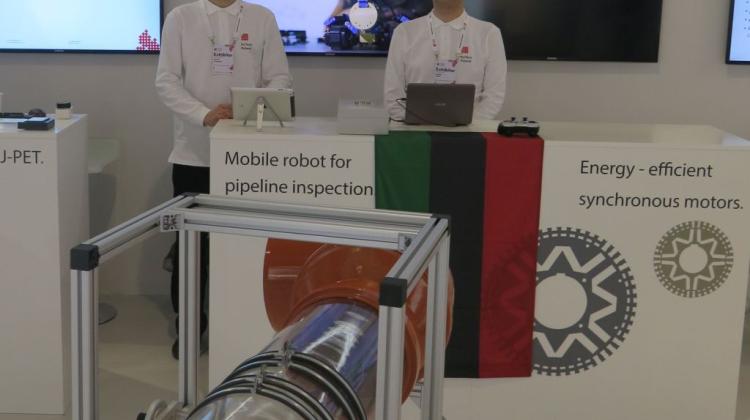Size-adjusting pipe robot developed at AGH

Where a man can not tread, he will send a robot. Researchers at AGH have built a pipe inspection robot that matches its shape to pipes with different cross-sections. The device can move in both horizontal and vertical installations, and even wade in the water.
The task at hand: examine the condition of water pipes. But the task is not so simple: the pipe is buried a few meters underground. In addition it is not exactly straight and horizontal, there are also vertical sections and bends. The pipe could also be narrowing in some places. Researchers from the Faculty of Mechanical Engineering and Robotics at AGH University of Science and Technology in Kraków have built a robot which, thanks to the innovative design developed by PhD student, Eng. Michał Ciszewski - will be able to cross such an obstacle course and examine the condition of such installations from the inside. The device will also be useful when inspecting ventilation ducts or gas pipelines. The robot can move in horizontal pipes with a diameter of at least 210 mm.
"We release the robot into the pipe. It goes through the installation and sends the image from the camera to the operator - via a cable. We can see clearly whether all the connections are well made and whether the pipe is pierced or damaged somewhere" - told PAP Łukasz Mitka, PhD student from AGH, who worked on the device.
What distinguishes the "pipebot" from AGH from other devices of this type that are already on the market is its ability to chance size depending on the pipe cross section. "If our robot travels through a larger diameter pipeline and reaches a narrowing, we can configure it to fit into the narrower pipe and continue the inspection" - said Mitka. He added that other available robots did not have this capability.
You can see the robot in action in the AGH video.
It may seem that this size change does not matter - after all, a smaller robot would fit into both smaller and larger pipes. But it is not that simple, especially when you have to climb a vertical section of a pipe or a steep slope. Then the size of the robot must be closely matched to the pipe diameter. The AGH robot moves on two tracks, which - thanks to six additional drives - can be set in preset positions - so that the robot can automatically expand and safely ride in a vertical pipe.
The robot is equipped with a camera that transmits live video image from inside the pipe. The sensors installed in the device (inclinometer, accelerometers and angular velocity sensors) allow to locate the robot in space and tell the operator where the damaged part of the pipe is. In addition, the robot is waterproof - it can work in partial immersion.
Mitka explained why the robot is not remotely controlled. "The cable is necessary - it\'s the only possibility for now. Not only does it transmit live camera image, but also supplies power to the robot" - he said.
He added that in underground pipelines, wireless communication is quickly blocked by the ground, so the range of a remotely controlled robot would be too small. "We would not be able make a sensible inspection with a camera" - he said. He added that the cable the AGH robot is equipped with is 100 meters long.
Prototype of the device has already been built at AGH. Researchers now want to commercialise their device.
PAP - Science and Scholarship in Poland, Ludwika Tomala
lt/ agt/ kap/
tr. RL
Przed dodaniem komentarza prosimy o zapoznanie z Regulaminem forum serwisu Nauka w Polsce.














